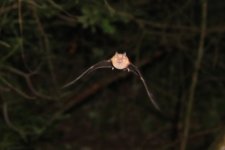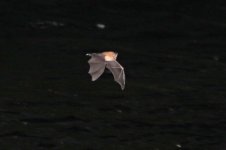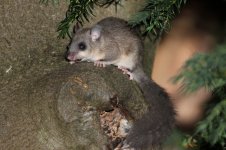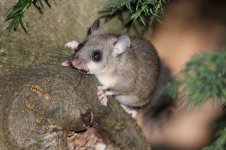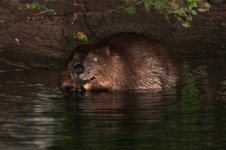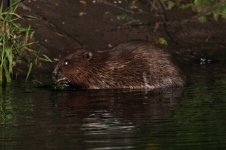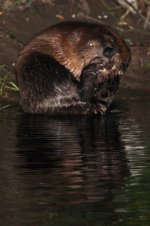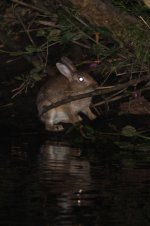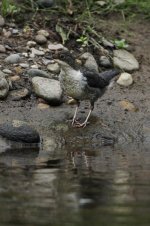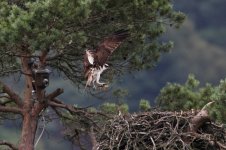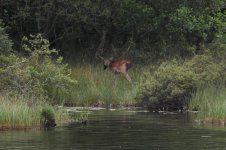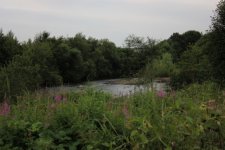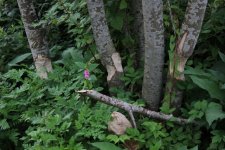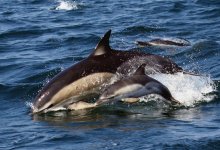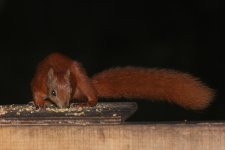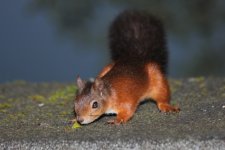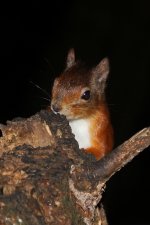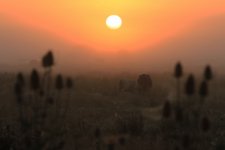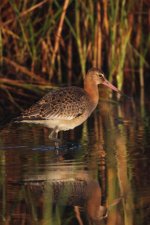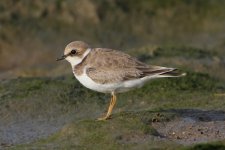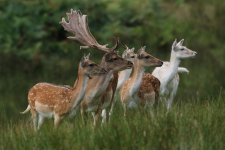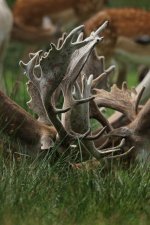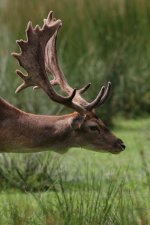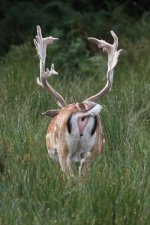On Saturday I had an overnight trip to the Isle of Wight, in search of my last breeding bat species: Grey Long-eared. I was armed with a site but well aware that this one was not "nailed on". However, the weather conditions appeared optimal with blazing sunshine, high temperatures and little or no wind. I went on via the ferry from Portsmouth, which was running a bit late due to exceptionally low tides and (according to a teller) particularly stupid grockles. I had very little from the boat, a few Common Terns and a single juvenile Black Tern being the pick of the bunch. Once on the island I headed for Alverstone Meads and spent a happy half hour with two glorious Red Squirrels, one as red all over as my hair used to be, the other distinctly and distinctively black-tailed.
Soon I decided to move on to check out my bat site with a bit of light left. As I drove away from Alverstone the consequences of heat, absence of wind and an island came to roost: a bank of sea mist rolled in. Bum.
I found the place and had a wander round. It was immediately apparent that this was going to be hard. It was only a feeding stop for the bats - they take almost exclusively large flying insect prey and prefer to hang up to eat it - and it looked as if the slatted wooden roof was where they dived in and out. I had been hoping for them using the wooden high-peaked porch but that had a door and windows instead of the open work I had expected.
I revised my plans and set up with a shorter lens with a wider field of view, focused generally on the roof slats. As the sky darkened only a few moths came out, and this continued throughout the session, probably due to the mist. Bats began to flick past my ear but seeing them proved almost impossible despite efforts with the naked eye, nightscope and red maglite on a wide setting, even with the couple of seconds notice my bat detector gave me.
A couple of times the calls cut off instead of fading out and I guessed these were bats hanging up to feed - but I wasn't seeing them going in and out and consequently had not chance of getting pix to check ID from.
Getting fed up I went to look at the porch. I couldn't see a lock on the door, which I now saw had metal grilles instead of windows and the grilles were ill-fitting. I tried it and it opened, so I slipped into the porch and scanned the planks and rafters with my nightscope. A bat! A Long-eared Bat, at that. Heart pounding with sudden adrenaline, I focused carefully. Dark face, dark tragus. This is the boy (or girl, I didn't sex it) all right. I turned to fetch my camera and clumsily kicked the door. I felt rather than saw the Grey Long-eared Bat go past me. You may imagine for yourselves what words go here.
Obviously I hung around for a long time afterwards but although I heard a few passes on the detector and checked the porch a few times I had no further luck. Perhaps I had used it all up, I certainly had no room to complain.
Eventually I decided to go and have a look at the landslip that cuts off the old Blackgang Road, which is also a Grey Long-eared Bat feeding area, but it was midnight and when I arrived there were seven cars in the car park. Perhaps as a mammal watcher I shouldn't say this but I decided not to either leave the car there unattended or risk my own fragile body around a probable bunch of weirdos.
On the way to the car park I had a Brown Rat run across the road and then a young Badger trotted up the road in front of me for some distance before turning off down a track.
Having pretty much exhausted the possibilities for the night, I decided to make the move to Yarmouth to wait for the 0430 ferry off. When I reached the terminal, a Wightlink employee cheerfully informed me that they were now running so late that the last ferry of the evening hadn't yet arrived much less departed, so I could take that if I liked.
Thus it was that I parked up at Lower Pennington Lane at about 0200 and slept till the rising sun woke me at about 0600. With the mist thinner here but not absent it all looked rather ethereal and pretty, so I staggered out of the Rover hotel and took up my camera to photograph the sunrise.
Once up I thought I might as well take advantage of the early light, kitted myself up and set off towards the sea. The Shoveler pools had a couple of very flighty Wood Sandpipers, some Redshanks and Dunlin and a few Teal. There were lots of Willow Warblers and a few Redstarts moving through the bushes.
I took the path along the base of the seawall and got some nice pix of Black-tailed Godwits before moving along to stake out the Curlew Sandpipers that were at the back of their lagoon. They worked their way forward and I got a few pix, then for no apparent reason they shot off.
I continued to the corner of the seawall, where a good few Med Gulls were in with the Black-heads, and scanned the mud and fingers of advancing tide.Among the Redshanks and Turnstones a Greenshank, a Little Stint and another Wood Sandpiper that just fell out of the sky prodded at and scuttled on the ooze.
Only a juvenile Ringed Plover deigned to come within reach of my lens, however, and as the sun began to scorch I made my way back to the Shoveler pools, where initially I was insulted almost to the point of violence. A photographer with a Sigma 150-500 was on top of the bank (there are notices saying don't stand up there) so I walked up and asked "what have you got?" - standard birder parlance I think you will agree.
The answer that came back was "I don't know, till I get home, same as you." Same as who? How very dare you! You twonk, just cos you either can't ID birds or judge your pix on the back of your camera, don't assume I can't either! Well, I don't know when I've ever been so....
It turned out that he couldn't ID birds to save his life. First he tried to string a Redshank into a Ruff, then he thought two Dunlin were Curlew Sandpipers and finally he wanted a Teal to be a Garganey. It is possible that a trace of relish crept into my corrections as he didn't stay much longer. I hope his results were better than his ability to caption them.
I settled myself low on the bank, overshadowed by brambles, and prepared for a long wait for a careless Wood Sandpiper.
Unfortunately not only one plonker was stalking the marshes Grendel-like on this fine morning. Two birdwatchers (bright clothing and cheap bins ruled out use of the word "birder") saw me lurking and sprang lightly up onto the bank, flushing every wader from the pools, and asked what I was watching. "Nothing", I replied a little sourly as every wader disappeared over the bank at the back. With nothing to look at, they continued towards the sea.
The next lot I actually didn't mind. They were grockles and none the worse for that. I found a child at my elbow who standing up was the same height as me sitting slumped. He regarded me gravely and then said "I've got a pair of binocularses." Why do so many kids not know how to stop saying binoculars? I laughed inwardly and asked where they were. They were at home. "That's no good, you need them with you." Yes. He turned and trotted back down the bank and after his family. Maybe he will remember.
Unfortunately the last lot were back to form - but they were only on the fringe of knowing what birds were and showed an interest, and they even apologised for flushing things before I could remark on it. Pretty good.
After they had gone, the waders had a general reorganise and I finally got some not quite awful Wood Sand pictures, as well as some of the real Ruff. It was nearly midday and I remembered that the Night Heron had still been present the previous day. I keep month lists and wasn't sure if Night Heron was an August tick, so I popped into the fishing ponds on my way out and clocked it through someone else's scope. BTW it was an August tick.
The New Forest is no joke on a hot day in summer, the roads are as full of terror as the coast. Despite bicycles, slow drivers, erratic drivers, ponies and cows I made it to Bolderwood in one piece by something after 1300, and having checked there were some Fallow Deer about, decided to wait for feeding time.
It was hot but under the trees not unbearable. The crowd was genial and we did get occasional distant views of the deer, including a hugely antlered buck that powered through the bracken to find a cool spot in the woodland edge to lie down and try to endure the flies.
The warden with the sack of nuts rocked up after 1400 and the deer were on the food immediately, giving great views. The bucks had completed removing their velvet and the bare antlers gleamed in the sun, while their full summer spotty coats were in peak condition. Most were standard colour, with a scattering of menil (pale) and only one near-white brocket.
As the deer dispersed having gorged themselves, I began to feel the effects of the past twenty-four hours and made for home where Marion greeted me with ready-cooled beer from the fridge. What a woman.
Pix later.
John
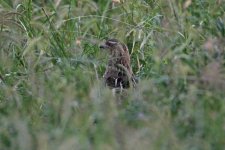 2012_07_08_Quail (2) (640x427).jpg203.6 KB · Views: 117
2012_07_08_Quail (2) (640x427).jpg203.6 KB · Views: 117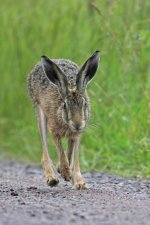 2012_07_08_Lagomorphs_Brown_Hares (7) (427x640).jpg189.3 KB · Views: 81
2012_07_08_Lagomorphs_Brown_Hares (7) (427x640).jpg189.3 KB · Views: 81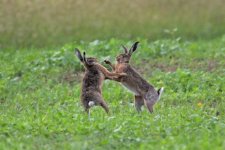 2012_07_08_Lagomorphs_BrownHares (2) (640x427).jpg191.4 KB · Views: 73
2012_07_08_Lagomorphs_BrownHares (2) (640x427).jpg191.4 KB · Views: 73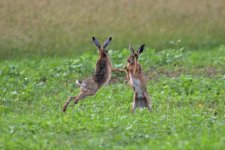 2012_07_08_Lagomorphs_BrownHares (4) (640x427).jpg198.9 KB · Views: 75
2012_07_08_Lagomorphs_BrownHares (4) (640x427).jpg198.9 KB · Views: 75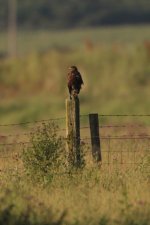 2012_07_08_Harris_Hawk (427x640).jpg160.8 KB · Views: 90
2012_07_08_Harris_Hawk (427x640).jpg160.8 KB · Views: 90



